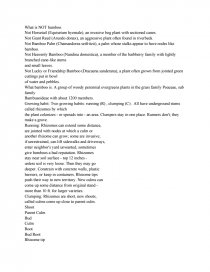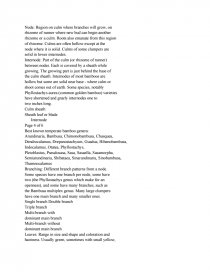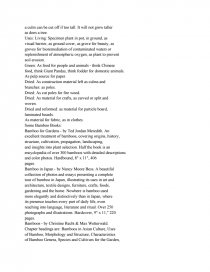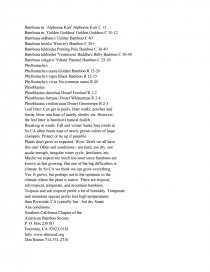Earth Partners
Essay by Maxi • February 14, 2012 • Essay • 2,045 Words (9 Pages) • 1,603 Views
What is NOT bamboo.
Not Horsetail (Equisetum hyemale), an invasive bog plant with sectioned canes.
Not Giant Reed (Arundo donax), an aggressive plant often found in riverbeds.
Not Bamboo Palm (Chamaedorea seifritzii), a palm whose stalks appear to have nodes like bamboo.
Not Heavenly Bamboo (Nandina domestica), a member of the barbberry family with lightly branched cane-like stems
and small leaves.
Not Lucky or Friendship Bamboo (Dracaena sanderana), a plant often grown from jointed green cuttings put in bowl
of water and pebbles.
What bamboo is. A group of woody perennial evergreens plants in the grass family Poaceae, sub family
Bambusoideae with about 1200 members.
Growing habit: Two growing habits: running (R) , clumping (C) . All have underground stems called rhizomes by which
the plant colonizes - or spreads into - an area. Clumpers stay in one place. Runners don't; they make a grove.
Running: Rhizomes can extend some distance,
are jointed with nodes at which a culm or
another rhizome can grow; some are invasive;
if unrestrained, can lift sidewalks and driveways,
enter neighbor's yard unwanted, sometimes
give bamboos a bad reputation. Rhizomes
stay near soil surface - top 12 inches -
unless soil is very loose. Then they may go
deeper. Constrain with concrete walls, plastic
barriers, or keep in containers. Rhizome tips
push their way to new territory. New culms can
come up some distance from original stand -
more than 10 ft. for larger varieties.
Clumping: Rhizomes are short, new shoots,
called culms come up close to parent culm.
Shoot
Parent Culm
Bud
Culm
Root
Bud Root
Rhizome tip
Shoot
Bud
Identification: Classification of a bamboo species
depends on observation and description of
all its parts: rhizome, culm, culm sheath,
branching habit, leaves, and finally flowers -
and consequent seeds - which are most difficult
to observe because most bamboos flower very
infrequently - 20+ years. Further, nature
plants can often look quite different from juvenile
or just-out-of-the container nursery stock.
Page 1 of 6
Page 2 of 6
Bamboo from the ground up.
Preferred soil: loose, loamy, well drained, moderately
acidic.
Rhizome: Underground stem from which the
roots grow. Grows horizontally near surface.
Sometimes runner loops above ground and
goes back down.
Clumping
Running
Growing point
Active cell division
(growth)
and differentiation
takes place
here just behind
where a sheath
connects
Sheath
Page 3 of 6
Sulcus
Node
Culm
Sheath ring
or scar
Nodal ridge
Culm: The vertical stem. Solid on some species,
hollow on most except at nodes. Diameters from 1/8
in. to 12 in. They push out of the soil the diameter
they will always be. Heights from few 1 ft to 100 ft.
Grows to full height in one year, then persists for several
years increasing number or side branches and
branchlets. Larger varieties can extend one or two
feet a day when growing. Fun to watch.
Colors can change over time. Most fresh-out-ofthe-
ground culms are a shade of green from yellowgreen
to dark green. Some start light green, turn yellow,
some start green and turn black, some have
splotches, some have vertical stripes. Some favorites
are B. vulgaris for its yellow culm with "hand painted"
green stripes. There are several clumping species
whose culms come up green then age to a brownblack
with small green stripes.
When the sheath falls off or dries up, no further
linear growth takes place in culm. Branches may
grow centered behind the center of the base of the
sheath. Branches can begin forming while the sheath
is growing, or can form several years later.
Culm
...
...









